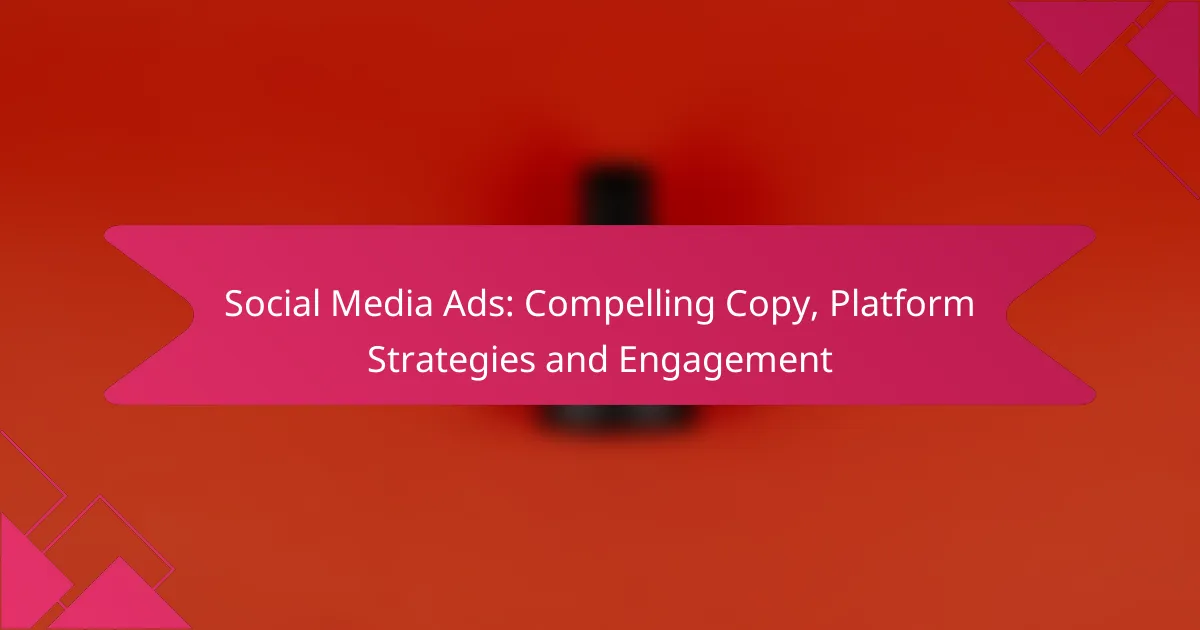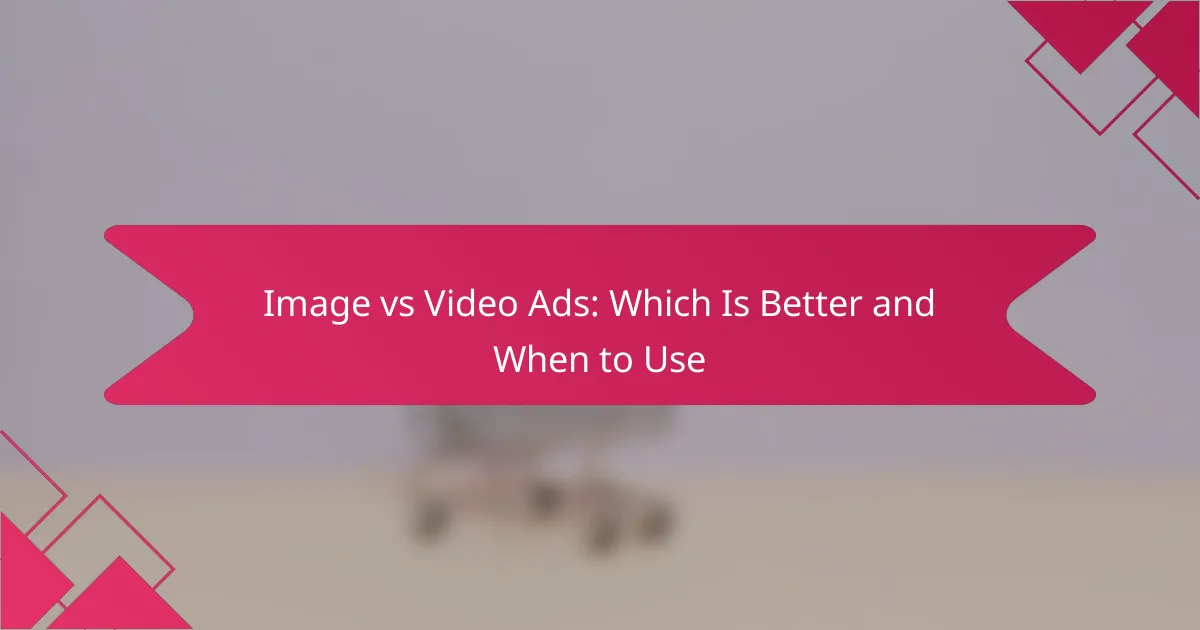In today’s digital landscape, creating compelling video content for social media ads is essential for capturing audience attention and driving engagement. By focusing on storytelling, mobile optimization, and platform-specific features, brands can effectively communicate their message. Implementing engagement strategies, such as interactive content and influencer partnerships, further enhances ad performance, while adhering to best practices ensures maximum impact and return on investment.

How to create effective video content for social media ads?
Creating effective video content for social media ads involves engaging storytelling, optimizing for mobile, and utilizing platform-specific features. Focus on delivering your message quickly and clearly to capture viewer attention and drive engagement.
Use storytelling techniques
Storytelling is a powerful way to connect with your audience emotionally. Begin with a relatable scenario or character that reflects your target demographic’s experiences or challenges. This approach can help viewers see themselves in your narrative, making them more likely to engage with your content.
Consider structuring your video with a clear beginning, middle, and end. Start by introducing the problem, then present your solution, and conclude with a strong call to action. This format keeps viewers interested and encourages them to take the next step.
Incorporate user-generated content
User-generated content (UGC) can enhance authenticity and trust in your brand. Encourage your customers to share their experiences with your product or service, and feature this content in your ads. This not only showcases real-life applications but also fosters community engagement.
When using UGC, ensure you have permission from the creators and give them credit in your videos. Highlighting real customer stories can resonate more deeply with potential buyers, making them feel more connected to your brand.
Optimize for mobile viewing
Since a significant portion of social media users access platforms via mobile devices, optimizing your videos for mobile viewing is crucial. Use vertical or square formats to maximize screen space and ensure your content is easily viewable without requiring users to rotate their devices.
Keep videos short and engaging, ideally under 30 seconds, to cater to shorter attention spans. Use eye-catching visuals and clear audio to maintain interest, as many users watch videos without sound.
Utilize captions and text overlays
Incorporating captions and text overlays can significantly enhance viewer comprehension, especially for those watching without sound. Use concise, impactful text to highlight key messages or calls to action throughout your video.
Ensure that the text is legible and contrasts well with the background. This practice not only aids in understanding but also makes your content more accessible to a wider audience, including those with hearing impairments.
Leverage platform-specific formats
Each social media platform has unique video specifications and audience preferences. Tailor your content to fit these formats, whether it’s Instagram Stories, TikTok videos, or Facebook ads. Research the optimal video length, aspect ratio, and style for each platform to maximize engagement.
For instance, TikTok favors short, creative videos that often include trending music, while Facebook may benefit from longer, more informative content. Adapting your approach can significantly impact the effectiveness of your campaigns.

What engagement strategies boost social media ad performance?
Engagement strategies that enhance social media ad performance include fostering interaction, using interactive content, and leveraging influencer partnerships. These methods can significantly increase user involvement and improve ad effectiveness.
Encourage audience interaction
Encouraging audience interaction is vital for boosting engagement. Ask questions, prompt discussions, or invite users to share their experiences related to your brand. This not only increases comments and shares but also builds a community around your content.
To maximize interaction, consider using clear calls-to-action (CTAs) in your ads. Phrases like “Tell us your thoughts!” or “Share your favorite!” can motivate users to engage more actively.
Utilize polls and quizzes
Polls and quizzes are effective tools for driving engagement on social media. They provide a fun way for users to express their opinions or test their knowledge, making them more likely to participate. Incorporating these elements into your ads can lead to higher interaction rates.
For example, you might create a quiz related to your product or industry, offering a small incentive for completion, such as a discount or entry into a giveaway. This approach not only engages users but also provides valuable insights into their preferences.
Host live Q&A sessions
Live Q&A sessions can significantly enhance user engagement by allowing real-time interaction. These sessions enable brands to address audience questions directly, fostering a sense of connection and trust. Promote these events in advance to maximize attendance.
During the session, encourage viewers to ask questions and share their thoughts. This not only keeps the conversation flowing but also helps you gather feedback and insights directly from your audience.
Implement retargeting campaigns
Retargeting campaigns are essential for re-engaging users who have previously interacted with your ads or website. By showing tailored ads to these users, you can remind them of your offerings and encourage them to take action. This strategy often leads to higher conversion rates.
To implement effective retargeting, segment your audience based on their previous interactions. For instance, create different ads for users who viewed specific products versus those who added items to their cart but did not complete the purchase.
Collaborate with influencers
Collaborating with influencers can amplify your ad performance by tapping into their established audiences. Influencers can create authentic content that resonates with their followers, leading to increased trust and engagement with your brand.
When choosing influencers, consider their relevance to your niche and the engagement levels of their audience. A well-targeted influencer partnership can yield significant returns, often resulting in higher engagement and conversion rates than traditional ads.

What are the best practices for social media advertising?
The best practices for social media advertising focus on setting clear goals, understanding your audience, experimenting with various formats, continuously monitoring performance, and ensuring brand consistency. These strategies help maximize engagement and return on investment.
Define clear objectives
Establishing clear objectives is crucial for effective social media advertising. Goals may include increasing brand awareness, generating leads, or driving sales. Specific, measurable objectives help guide your campaign strategy and enable you to assess success.
For example, instead of a vague goal like “increase engagement,” aim for “boost post engagement by 20% over the next month.” This clarity allows for targeted actions and easier evaluation of results.
Analyze audience insights
Understanding your audience is key to tailoring your ads effectively. Utilize analytics tools to gather insights about demographics, interests, and online behavior. This data helps you create content that resonates with your target market.
Consider segmenting your audience based on factors like age, location, and preferences. This segmentation allows for more personalized messaging, which can significantly enhance engagement rates.
Test different ad formats
Experimenting with various ad formats can reveal what works best for your audience. Options include image ads, video ads, carousel ads, and stories. Each format has unique advantages and can cater to different engagement styles.
For instance, video ads often capture attention more effectively than static images. Running A/B tests can help you compare performance metrics and optimize your ad strategy based on real data.
Monitor and adjust campaigns
Regularly monitoring your advertising campaigns is essential for success. Track key performance indicators (KPIs) such as click-through rates, conversion rates, and engagement metrics. This ongoing analysis allows you to identify trends and make necessary adjustments.
Be prepared to pivot your strategy based on performance. If a particular ad format or message isn’t resonating, don’t hesitate to change it. Flexibility can lead to improved results over time.
Maintain brand consistency
Consistency in branding across all social media ads reinforces recognition and trust. Ensure that your visual elements, tone, and messaging align with your overall brand identity. This coherence helps create a unified experience for your audience.
For example, use the same color palette and logo across all platforms. Additionally, maintain a consistent voice in your copy, whether it’s professional, casual, or humorous, to strengthen brand loyalty and recall.

What metrics should you track for social media ad success?
To measure social media ad success, focus on key metrics such as engagement rate, click-through rate, conversion rate, and return on ad spend. These metrics provide insights into how well your ads resonate with your audience and their effectiveness in driving desired actions.
Engagement rate
Engagement rate is a crucial metric that indicates how actively your audience interacts with your social media ads. It is typically calculated by dividing the total number of engagements (likes, shares, comments) by the total reach or impressions, then multiplying by 100 to get a percentage.
A high engagement rate suggests that your content is resonating with viewers, while a low rate may indicate that your messaging or targeting needs adjustment. Aim for engagement rates that fall within the range of 1-5% for most platforms, but this can vary by industry and audience.
To improve engagement rates, consider using eye-catching visuals, compelling calls to action, and interactive elements like polls or quizzes. Avoid overly promotional content, as it can lead to disengagement. Regularly analyze your engagement metrics to refine your strategies and enhance audience interaction.










